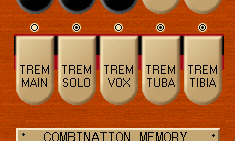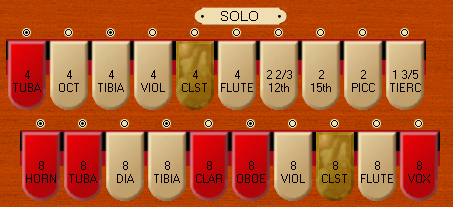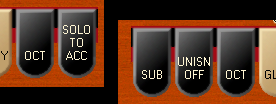
Miditzer Console
Other Tabs...
Possibly the most important tabs on
a theatre organ are the five white
tabs at the lower right labeled "TREM" for tremulant. These
impart a warbling quality to the affected pipe ranks. American
theatre organists play with all the trems on most of the time while
British organists use the trems a bit less. Some ranks such as
the Tibia and Vox Humana are almost never heard without
tremulant.
The trems labeled Vox, Tuba, and Tibia affect just those ranks.
(The Tibia is not on a separate trem on a real 216. This is a
modernization of the 216.)


The black tabs are couplers. The couplers cause the playing of one key on the keyboard to have the effect of playing an additional key. The Solo has three intra-manual couplers. If the SUB is on the effect is as if you were also playing the key an octave below the key you are playing.
If the OCT is on
the effect is as if you were also playing the key an octave above the
key you are playing. If the Unison Off coupler is on the effect
is as if you were not playing the key you are playing.

The Accompaniment has one intra-manual coupler, the OCT coupler which
works like the Solo's OCT coupler. The Accompaniment also has one
inter-manual coupler, SOLO TO ACC. If the SOLO TO ACC is on the effect
is as if you were playing the key you are playing on the Accompaniment
manual on the Solo manual as well.
The Style 216 was the only 2 manual Wurlitzer that included
couplers. The use of couplers can make a registration sound much
fuller. I still don't have MIDI pedals, so I frequently will use
the SUB coupler to provide a bottom end without the use of
pedals. Without the Tibia modernization, one can obtain the "hole
in the middle" registration used for open harmony by turning on the 8'
Tibia and the Sub, Unison Off, and Octave couplers. This is
effectively a 16' plus 4' Tibia registration. My recording of the
Maori Farewell Song demonstrates this sound.
Last update 14 June 2005 Russ Ashworth